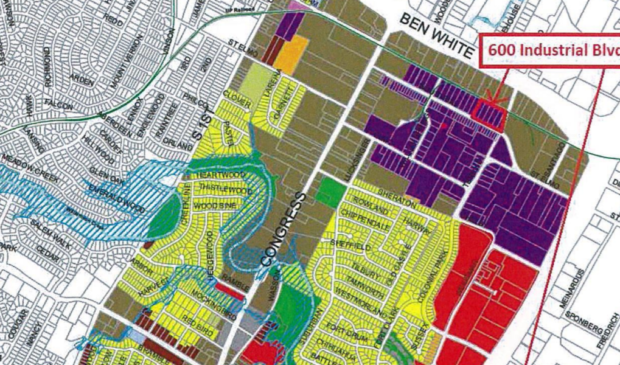South Austin industrial site approved for mixed-use residential
Monday, February 10, 2020 by
Ryan Thornton Industrial Boulevard in South Austin is a historically industrial area on its way to becoming a lively residential and commercial neighborhood. City Council opened the door to further transformation of the area Thursday by approving a mixed-use zoning request at 600 Industrial Blvd.
The 4-acre site now contains a few industrial warehouses, but Keller Capital plans to replace those with 400 multifamily units, nearly 13,000 square feet of retail, and a combination brewery and beer garden.
Council gave final approval for the zoning request in a 7-0-2 vote with Council members Leslie Pool and Alison Alter abstaining and Kathie Tovo and Greg Casar off the dais. The site’s limited industrial zoning (LI-CO-NP) was changed to mixed-use with conditions (LI-PDA-NP).
Over the past two decades, Council has approved seven zoning changes that allow for residential use in the area, but these are generally closer to South Congress Avenue, an Imagine Austin corridor, and the South Congress Transit Center. This property, in contrast, is 2,300 feet from the corridor and does not have sidewalks or bike lanes to help people get to transit stations.
As part of site construction, however, Keller Capital has agreed to pay roughly $223,000 in fee-in-lieu payments to the city for construction of a sidewalk and buffered bike lane on Industrial Boulevard as well as a sidewalk on the west side of Terry-O Lane to the east.
The developer is also planning to make accommodations for a potential Bergstrom Spur Corridor urban trail bordering the site to the north and running east-west between Vinson Drive and U.S. Highway 183. David Hartman, representing the applicant, said the developer has been considering the shared-use trail more closely since Council Member Ann Kitchen pointed out its potential at first reading in November last year.
One of those accommodations has led to the decision to provide on-site parking for people wishing to access the trail in the future or visit one of the neighborhood breweries or other commercial sites.
Mario Cantu, chair of the South Congress neighborhood contact team, said the neighborhood is not necessarily against such plans, but regretted that the developer had added that particular component to the neighborhood’s private restrictive covenant without notifying anyone of the change or discussing the potential impact to vehicle trips or safety.
As a whole, Cantu said the city needs to reconsider the impact such projects may be having in industrial areas in terms of lost jobs, displacement from rising property values and higher taxes. “Even though this might be just a little drop in the bucket, ask yourselves: Could this be disruptive to a family or somebody else?” he told Council.
The city’s report on the request states that the loss of industrial areas may be putting the city at risk of losing more middle-skill jobs that are needed for a strong workforce. Residential and mixed-use developments like these can create more pressure to push out industrial sites and ultimately pose a risk to the local economy.
To address this, the Planning and Zoning Department is recommending that the city conduct a study to determine the impact new mixed-use projects are having on industrial areas and explore how to address any negative consequences. Specifically, the study will look at strong industrial areas and consider whether these should be preserved through the use of zoning districts or allowed to evolve with market demand.
Ultimately, Cantu said the neighborhood does not support the project’s proposal for dedicated affordable housing units. Because the site will be allowed up to 90 feet in height (tall for the neighborhood), the neighborhood team had been asking for 10 percent of units to be dedicated at 60 percent of median family income.
“That’s where we know that true affordable housing will impact our area, and not just our area, but all parts of the city,” Cantu said.
While the applicant refused that demand, the plan does include dedication of 6 percent of units at 60 percent MFI and 4 percent of units at 80 percent MFI.
Map courtesy of the city of Austin.
The Austin Monitor’s work is made possible by donations from the community. Though our reporting covers donors from time to time, we are careful to keep business and editorial efforts separate while maintaining transparency. A complete list of donors is available here, and our code of ethics is explained here.
You're a community leader
And we’re honored you look to us for serious, in-depth news. You know a strong community needs local and dedicated watchdog reporting. We’re here for you and that won’t change. Now will you take the powerful next step and support our nonprofit news organization?



